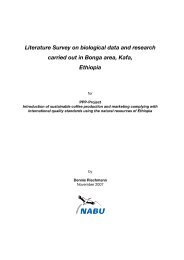Flora Biodiversity Assessment in Bonga, Boginda and Mankira Forest
Flora Biodiversity Assessment in Bonga, Boginda and Mankira Forest
Flora Biodiversity Assessment in Bonga, Boginda and Mankira Forest
You also want an ePaper? Increase the reach of your titles
YUMPU automatically turns print PDFs into web optimized ePapers that Google loves.
7. ANNEXES<br />
Annex I. Def<strong>in</strong>itions<br />
<strong>Forest</strong><br />
“<strong>Forest</strong> is l<strong>and</strong> with tree crown cover (or equivalent stock<strong>in</strong>g level) of more than 10<br />
percent <strong>and</strong> area of more than 0.5 hectares (ha). The trees should be able to reach<br />
a m<strong>in</strong>imum height of 5 meter at maturity <strong>in</strong> situ”, (FAO, 2002).<br />
Tree<br />
“Tree is a woody perennial with a s<strong>in</strong>gle ma<strong>in</strong> stem, or <strong>in</strong> the case of coppic<strong>in</strong>g with<br />
several stems, hav<strong>in</strong>g a more or less def<strong>in</strong>ite crown. Includes: Bamboo, palms,<br />
<strong>and</strong> other woody plants meet<strong>in</strong>g the above criterion”, (FAO, 2002).<br />
Shrubs<br />
“Shrubs refers to vegetation types where the dom<strong>in</strong>ant woody elements are shurubs,<br />
i.e., woody perennial plants, generally of more than 0.5 meter <strong>and</strong> less than 5<br />
meter <strong>in</strong> height on maturity <strong>and</strong> without a def<strong>in</strong>it crown”, (FAO, 2002).<br />
Core<br />
Buffer<br />
“The core area needs to be legally established <strong>and</strong> give long-term protection to the<br />
l<strong>and</strong>scape, ecosystem <strong>and</strong> species it conta<strong>in</strong>s. It should be sufficiently large to meet<br />
these conservation objectives. As nature is rarely uniform <strong>and</strong> because of historical<br />
l<strong>and</strong>-use constra<strong>in</strong>ts, there may be several core areas <strong>in</strong> a s<strong>in</strong>gle biosphere reserve to<br />
ensure a representative coverage of the mosaic of ecological systems. Normally, the<br />
core area is not subject to human activity, except for research <strong>and</strong> monitor<strong>in</strong>g <strong>and</strong>, as<br />
the case may be, for traditional extractive uses by local communities”, (UNESCO,<br />
2006).<br />
“The buffer zone (or zones) is clearly del<strong>in</strong>eated <strong>and</strong> surrounds or is contiguous to<br />
the core area. Activities are organized here so that they do not h<strong>in</strong>der the<br />
conservation objectives of the core area but rather help to protect it, hence the idea<br />
of "buffer<strong>in</strong>g". It can be an area for experimental research, for example to discover<br />
ways to manage natural vegetation, cropl<strong>and</strong>s, forests, fisheries; to enhance high<br />
quality production while conserv<strong>in</strong>g natural processes <strong>and</strong> biodiversity, <strong>in</strong>clud<strong>in</strong>g<br />
65



